Hanse 418: Faster, more comfortable and more luxurious - cruising yacht bestseller put to the test
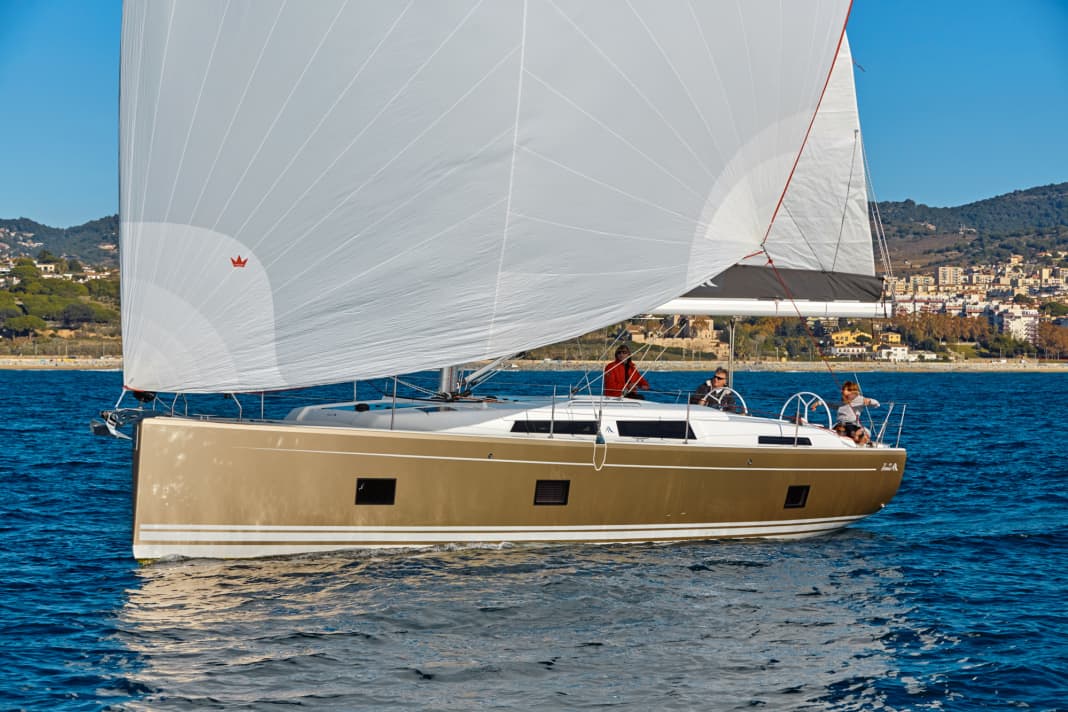





After a period of relative calm, 2018 was another exciting year for the shipyard scene in the large series yacht segment. Jeanneau modified its Sun Odyssey series and created something fundamentally new, such as the walkaround cockpit. Beneteau from the same shipyard group revised the Oceanis line. Bavaria Yachtbau also launched boats under 50 feet, such as the Bavaria C42, which look radically different from a shipyard perspective.
And the Hansegroup? The second largest series manufacturer in the world after the French Beneteau Group came to the 2017/2018 trade fair season with four new products: 348, 548, 388 and the 418 tested here.
The intention of the shipyard in Greifswald was to further develop the cardinal virtues of Hanseatic yachts: more comfort and more sailing performance that is easier to call up. They continued to rely on the proven hulls of the recognised fast designs of the equally successful and versatile Judel/Vrolijk design team, but invested in all other areas. In concrete terms, according to Pascal Kuhn, Product Manager Sailing Yachts: "The deck, rigging, keels, inner shells and furniture are all new; this is much more than a facelift." And the aim is to offer more light and transparency in the interior. This is particularly obvious given the external appearance of the Hanse 418.
More window areas, but poor ventilation
The simple rectangular hull windows made of real glass have grown considerably compared to the previous model and are more favourably positioned. There are two large forward hatches, two smaller ones and an additional fixed window in the roof. So-called atriums on both sides of the companionway illuminate the aft cabins and the aft saloon.
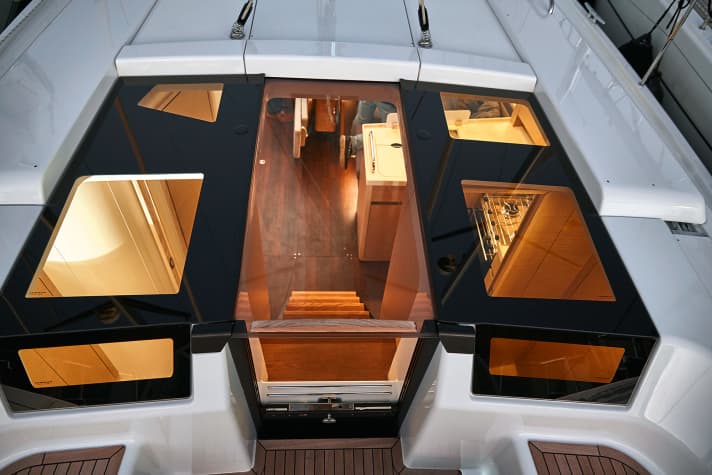
However, good ventilation can only be achieved in the aft cabins with optional hatches; only the cockpit windows can be opened as standard. Ventilation is also an issue in the saloon on the Hanse 418: while all the superstructure windows on the predecessor model 415 could still be opened for effective transverse ventilation, only a small hinged window is now installed in the pantry window. That works better.
L-keel is more effective than conventional T-keels
Another innovation in the cockpit is the elimination of the permanently installed wheel wells behind the two wheels in favour of optional fold-up seats. The stern is therefore completely open if the manually folding bathing platform, which is available at extra cost, is not ordered. The storage space in the original aft seat recesses has been replaced by usable space in the cockpit floor below. Lines, fenders, life raft and much more can be stored there. There is another locker in the starboard cockpit; the shipyard has dispensed with the one opposite in order to give the aft cabin on the port side more headroom and a more generous impression of space. Unfortunately, the forecastle in the dinghy is not available as an option.
Other changes are perhaps more important from a technical point of view: The shipyard no longer offers T-keels, which have the disadvantage of forking up flotsam such as nets, lines or seaweed and are almost impossible to release. T-keels are not for sale in the US market, particularly on the east coast. "What's more," says Matthias Bröker, Hanse consultant at the Judel/Vrolijk design office, "the keel becomes less effective if the fin above the bomb is longer than it is high." The lift is then less than with an L-keel, whose narrower bomb is partially attributable to the fin in terms of area. Or also: The L-keel generates more lift than the T-keel.
Small sail area, code zero as an option
The total displacement and the ballast ratio have remained largely the same. Equipped with a self-tacking jib and mainsail, the sail load factor, which compares the standard sail area on the wind with the total weight, is relatively low at 4.2.
A genoa and tracks are no longer offered as an extra by the shipyard. For extra cloth, the shipyard offers a rollable Code Zero, which is set on its own stay and sheeting over the spinnaker hoist points (or the stern cleats). The sail from Elvström is sold by Hanse under the name Crossover, is about twice as large as the jib at around 77 square metres and costs 6962 euros extra with furler from Seldén.
An alternative for more pressure on deeper courses would be a gennaker, which measures as much as 120 square metres and costs around 3400 euros without the periphery of halyard, sheets, blocks, padeyes and perhaps a recovery tube.
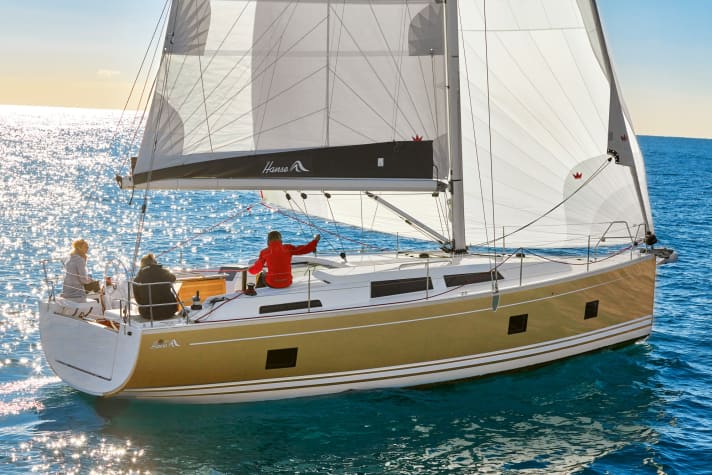
The potential of the Hanse 418 is emerging
And fortunately the gennaker is on board for testing off Barcelona. With old swells pushing the Mistral outliers onto the coast, ignoring the weak thermal winds, it needs space and patience. The conditions are not suitable for meaningful measurements; if the wave does not shake the little wind out of the sails for a moment, potential can be surmised but not proven.
The reference to the renowned designers of Judel/Vrolijk & Co. and the experience with the predecessor ship, which was built over 200 times, must serve as an assurance of superior sailing characteristics.
What is noticeable, however, is that with one and three-quarter turns from stop to stop, the boat steers directly enough with the 90-centimetre wheels. Incidentally, the standard version includes stainless steel wheels that do not match the look of the boat; thicker GRP parts from Carbonautica in white or black are an extra.
The Hanse 418 is perfectly suitable for single-handed use
The view forwards of the waves and wind lines in the foresail is good, you sit relatively relaxed, but you can't lean back perfectly. The helmsman has direct access to the aft winches, to which the halyards and outhauls are also led. This makes the boat perfectly suitable for single-handed sailing. The plotter and compass are mounted centrally on the rear edge of the fixed cockpit table (for which a refrigerator is offered as an option). While the plotter is still easy to read, this is less true of the compass. Two north pointers mounted in the helmsman's line of sight or at least on the steering columns would make more sense. An alternative is an electronic compass with a large display on the trailing edge of the mast.
The lines are sorted away in side stowage boxes. The mainsheet runs from the roof to the winches without travellers and with a 1:4 reduction on both sides, the jib to the drum on the starboard side. In a wave, the self-tacking jib slides from one side to the other, even without the sail set. Stoppers or a simple line arrangement would be useful here, but they are easy to retrofit yourself.
So engine on: The standard Yanmar with 39 hp pushes the boat to 7.2 knots when cruising at 2600 rpm. The maximum noise level in the aft chamber is 75 db(A). The manoeuvring characteristics are almost inconspicuous, only reversing with the engine engaged seems to be a little more unwilling to one side than the other. Alternatively, a 57 hp unit from the same manufacturer can be ordered. The engine is easy to service from all three sides, and the seawater filter and saildrive seacock are also easy to reach.
Many options - for an extra charge
This is ensured by side hatches in the aft cabins and the companionway steps, which can be easily swivelled up. It runs at a pleasant angle into the ship and is easy to access with five steps. The saloon is bright and friendly and more cosy than on the previous boat thanks to an increased proportion of wood, for example on the main bulkhead.
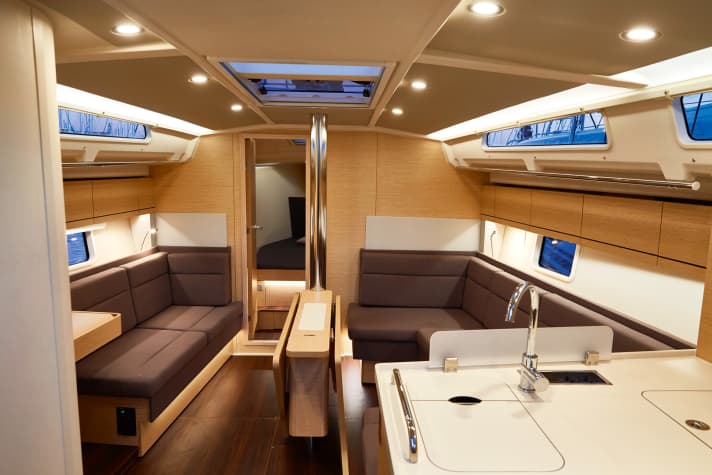
As standard, the furniture is veneered with dark, silk matt lacquered mahogany, the floor is coated with light-coloured acacia and the worktop is black with white speckles. There is a choice of four other woods, including the so-called French oak as on the test ship, darker or lighter or striped floors and a cream-coloured worktop. There is also a choice of two shades of grey for the wall units. The long galley line and only one aft cabin on the port side with a large walk-in locker on the opposite side are also standard.
No matter which version is chosen: What stands out positively are the screwed and creak-free floorboards, highly welcome stainless steel handrails on both sides of the ceiling, lots of spotlights, reading lamps and indirect lighting (programmable as an extra) as well as the very large water tanks with a total capacity of 475 litres. The 43 x 25 centimetre hull windows create beautiful views, especially under sail or at anchor.
Minor weaknesses of the Hanseatic League 418
The fuses, which are difficult to reactivate after tripping even if a replacement is available, and the large saloon table, which appears unstable when opened, are to be criticised.
Most of the changes compared to the 415 have been made in the foredeck area. The two side seats, which were questionable anyway, have been removed and the berth has now been designed as an island bed with the head end facing forwards. This has cost shoulder width, the sleeping area is now only 1.45 metres wide, but the total area has increased. And when lying in bed, you can now see directly into the sky through the front hatch ...
A shower room is available in the foredeck on request; the berth can then be turned round and pushed forward without the bookshelf on the anchor locker bulkhead. In both cases, there is enough legroom in the spacious forward cabin, which will be chosen as the owner's cabin in most cases.
The bathroom has also been remodelled. Whereas the shipyard used to have a toilet room with a washbasin and adjoining separate shower, the (coverable) toilet and shower are now located in the same compartment. This measure has freed up some space in the washroom. The headroom in this segment is at least 1.91 metres; in the saloon and also in the cabins it rises to up to 1.97 metres.
Measured values Hanse 418
Sailing performance*, without drift and current

Wind speed: 8 kn (3 Bft.), wave height: swell approx. 1 metre
*According to VPP ** With gennaker
Potential

With standard sails, the sail carrying capacity is quite low
Berth dimensions
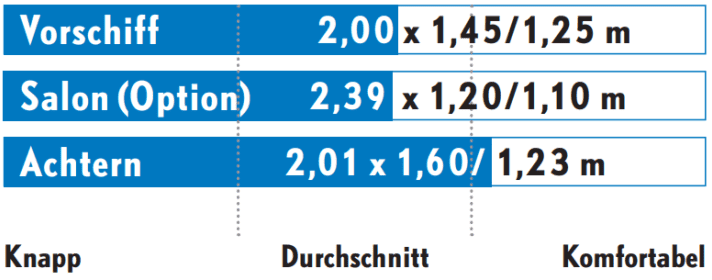
YACHT review Hanse 418
Modern cruising yacht in an independent design with plenty of space, lots of comfort, neat features and well thought-out details. And attractively priced. A package that you can't go wrong with
Design and concept
- + Proven design
- + Various options
- - Little sail area in the standard version
Sailing performance and trim
- + High performance potential
- + Successful deck layout
Living and finishing quality
- + Appropriate room layout
- + Well utilised storage space
- - Saloon table unstable when unfolded
Equipment and technology
- + Upscale standard equipment
- + Large water tanks
- - Slippery surfaces on coaming/superstructure
Technical data Hanse 418
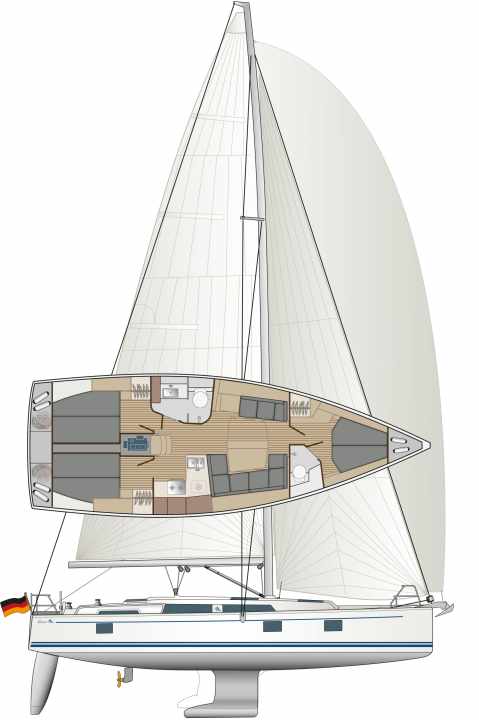
- Design engineer: Judel/Vrolijk & Co
- CE design category: A
- Torso length:11,99 m
- Waterline length:11,40 m
- Width: 4,17 m
- Draught/alternative: 2,10/1,74 m
- Weight: 9,8 t
- Ballast/proportion:2,9 t/29 %
- Mainsail:45,0 m2
- Self-tacking jib:34,5 m2
- machine (Yanmar):29 kW/39 hp
Hull and deck construction
Sandwich with balsa wood core, first layer vinylester resin. Full laminate underwater hull. GRP floor assembly
Base price ex shipyard
256,921 euros gross incl. 19 % VAT (as at July 2023)
Shipyard
This article first appeared in YACHT 02/2018 and has been revised for this online version.

